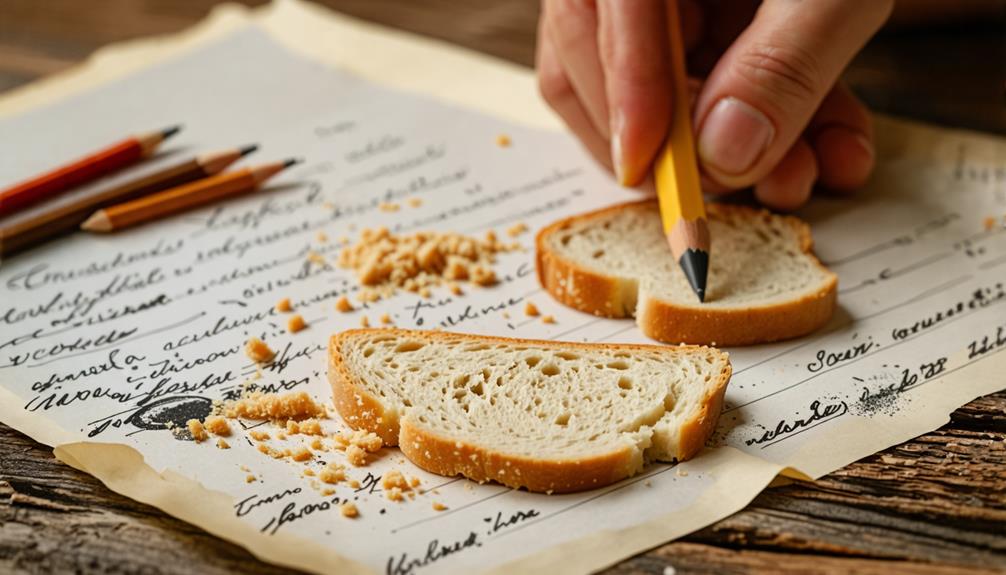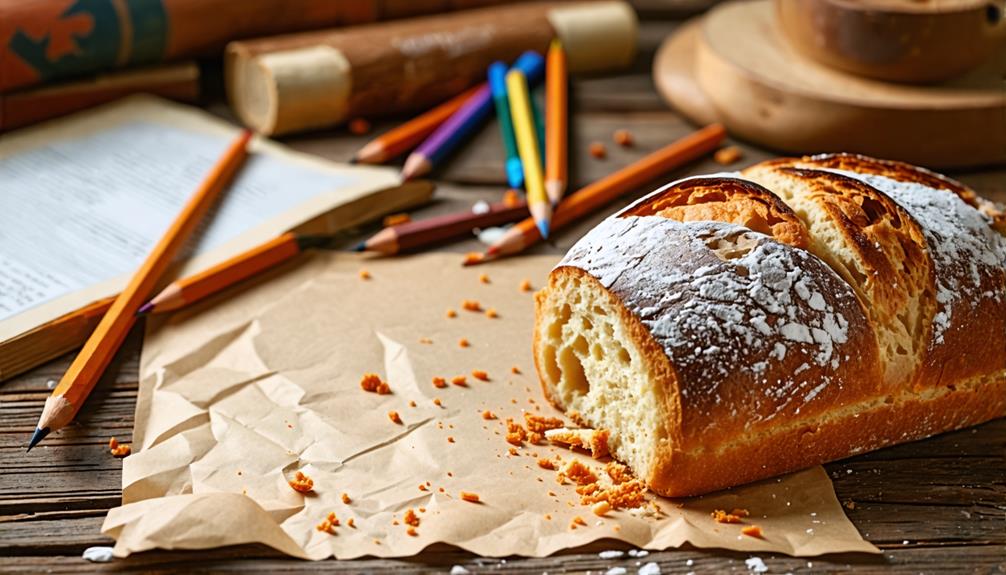You might think you know all about the history of writing tools, but there's a quirky chapter you've likely overlooked. Before the invention of rubber erasers, writers had a surprisingly tasty solution for correcting their mistakes: bread. That's right, your daily loaf once served double duty as both sustenance and stationery. This unusual practice wasn't just a last-resort option; it was the go-to method for tidying up pencil marks. But how exactly did a slice of bread manage to erase graphite, and why did this method eventually fall out of favor? The answers reveal an intriguing tale of innovation and necessity.
Key Takeaways
- Bread served as the primary eraser for removing pencil marks before the 1770s.
- Fresh bread was preferred over stale due to its superior absorbent qualities for erasing.
- The starch content in bread made it effective at lifting graphite marks from paper.
- Fine wheat loaves were favored by upper-class writers for erasing purposes.
The Age of Edible Erasers

In a quirky twist of history, you might've found yourself reaching for a slice of bread instead of a rubber eraser if you lived before the 1770s. For over 150 years, bread served as the go-to eraser for removing pencil marks from paper.
The absorbent qualities and soft texture of fresh bread made it surprisingly effective at erasing graphite smudges. You'd have discovered that fresher bread worked better than stale options, with fine wheat loaves being the preferred choice among upper-class writers.
This edible eraser highlights the resourcefulness of past societies, where everyday items were creatively repurposed for practical uses in writing and drafting.
The age of edible erasers came to an end with the introduction of rubber in 1770, marking a significant shift in writing tools and error correction methods.
Bread: An Unlikely Writing Tool
From ancient scribes to 18th-century scholars, you'd have found an unlikely writing tool in your kitchen: a simple loaf of bread. This soft, edible substance was surprisingly effective at erasing pencil marks. Here's why bread became the go-to erasing tool:
- Absorbent qualities, particularly starch content
- Ability to lift graphite marks efficiently
- Softness that didn't damage paper
- Readily available in most households
For over 150 years, students and scribes relied on bread to correct their writing. You'd knead the bread to the right texture, then gently rub it over the graphite marks you wanted to remove.
This practice persisted from 1612 until the late 18th century when rubber erasers were introduced. So, the next time you're jotting down notes, remember that your ancestors might've reached for a slice of bread instead of an eraser.
From Crumbs to Rubber Revolution

Before rubber's rise to eraser fame, you'd have found students and scribes kneading bread crumbs to correct their writing mistakes. The shift from bread to rubber erasers marked a revolutionary change in writing tools. Edward Nairne accidentally discovered rubber's erasing potential, leading to its marketing in Europe. By 1858, rubber erasers became widely accepted due to their superior performance in wiping away pencil marks.
| Year | Material | Characteristics |
|---|---|---|
| Pre-1770 | Bread | Absorbent qualities |
| 1770 | Rubber | Cleaner, efficient |
| 1858 | Rubber | Widely accepted |
| 1860s | Rubber | Integrated in pencils |
| Modern | Vinyl/Plastic | Improved durability |
This evolution showcases advancements in material technology. You'll find that modern erasers, often made from synthetic materials like vinyl, offer improved durability and effectiveness compared to their bread and early rubber counterparts. The journey from bread crumbs to rubber revolutionized how you correct black lead markings on paper.
Conclusion
You've just discovered a quirky slice of history! Next time you're jotting down notes, imagine using your sandwich to erase mistakes.
It's a far cry from the convenient erasers you're used to today. While you won't find bread in your pencil case anymore, this ingenious solution reminds you of human creativity.
So, appreciate your modern eraser, but don't forget the bread that paved the way for cleaner corrections.

Leave a Reply